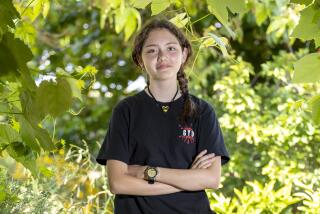Attention, Shoppers : Environmentalist Points Out Do’s and Don’t of Smart Buying in Market Tour
- Share via
PORT HUENEME — How many times have you seen someone with a bunch of bananas in a plastic bag?
Jessica Craven posed this question to her students as they stood outside the door of a Ralphs supermarket in Port Hueneme.
A few of her Saturday morning scholars looked down at the ground or at their hands. A couple laughed. One admitted, “I’ve done it myself.”
It seems unlikely any of the 10 will ever do it again. They are now graduates of the Environmental Shopping Tour, a free 1 1/2-hour passage through familiar grocery store aisles during which Craven imparts recycling tips, information about toxic chemicals and ways to avoid creating waste. One of her rules is not to use a plastic bag for something that comes in natural packaging, such as bananas.
The city of Port Hueneme asked Craven, who works for Oxnard’s Refuse Division, to bring her shopping do’s and don’ts to its consumers. The first tour was in early November. The remaining two are scheduled for tomorrow and Dec. 16.
Craven stops the group in the shampoo aisle and tells everyone to pick out a favorite brand and turn over the bottle. Most have a numeral 1 or 2 stamped inside a triangle.
But Craven pulls out a bottle with a numeral 3 marking. Of the seven plastic classifications, only numerals 1 and 2 are recyclable locally.
“We can write these companies and tell them we really like their products, but we want a product that’s recyclable,” Craven said. She hands out postcards made from recycled paper that carry a message encouraging such efforts.
*
Craven says consumer campaigns have already made a difference.
“A few years ago, I would grab any of these cooking oil containers and they were plastic No. 3, which is vinyl,” she said. “I grabbed every one this morning before the tour and they are all plastic No. 1.”
Still, Craven points out that recycling is not a perfect solution. “The manufacturing process itself takes a lot of energy. Energy is being used and pollutants are going out,” she said. “Looking for things that prevent waste eliminates that whole step.”
So she travels with a blue canvas sack that can be used to haul groceries. During the shopping tour, it contains plastic Tupperware (an alternative to paper lunch bags) and rags (the durable substitute for paper towels), among other props she uses to make her points.
Given a choice, Craven admits, she favors avoiding plastic altogether in favor of glass bottles or steel cans, both of which recycle easier. She buys bulk because that cuts down on overall packaging. She consumes organic fruits and vegetables to avoid pesticides, which can be washed back into the ground.
Her students had their own complaints about waste.
John Mooney of Oxnard asked if there was a way to make receipts smaller and fewer in number. “You go in for a pack of gum and get a receipt this long,” he said, holding his arms about three feet apart.
Craven points to bigger difficulties. Juice boxes, popular for school kids’ lunches, are created from layers of paper, aluminum and plastic and must be shredded to be recycled. Frozen foods, juice and milk are frequently packaged in wax-coated cardboard, which goes straight to the landfill.
*
At least one tour graduate went to put her newfound knowledge to immediate use by shopping after the program.
“It’s going to be a totally different look at packaging. I always used to think of convenience and buy lots of single-serving products,” said Jane Gamsby of Oxnard. “Even though what I do may not be much, it could help reduce some waste.”
For information about upcoming tours, call 986-6556.






